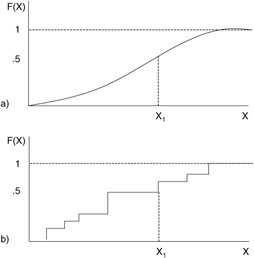5.3 Probability distributions
|
| < Free Open Study > |
|
5.3 Probability distributions
The concept of a random variable in and of itself does not lend itself to extensive practical use. To remedy this we define a distribution function for each random variable X. The distribution function is typically represented as:
| (5.36) |
By its definition, the distribution function assumes values from 0 to 1. Also, the distribution function is nondecreasing as x increases in value. These properties are summarized as follows:
| (5.37) |
| (5.38) |
| (5.39) |
Distribution functions are also called cumulative distribution functions, because at any x along the distribution, the area under the curve to the left of x represents the cumulative total of the probabilities of the random variables {x ≤ X}. Figure 5.3 shows some example distribution functions.

Figure 5.3: Example distribution functions.
From Figure 5.3, it is obvious on these functions are called distribution functions because they show exactly how the probability of the random variable is distributed over the range of the random variable values.
The distribution function shown in Figure 5.3a is a continuous function, because it is based upon a continuous random variable. Figure 5.3b shows a discrete distribution function that is based upon a discrete random variable.
A joint distribution is one that defines how the probability is associated with each of several random variables. Thus, we can state a function that defines a joint distribution as:
| (5.40) |
This function can be interpreted as:
| (5.41) |
We are also interested in the individual distribution functions of X and Y given the joint distribution of equation (5.40). For instance, the distribution of X given F(x,y), also called the marginal distribution function of X corresponding to F(x,y), is given as:
| (5.42) |
or
| (5.43) |
The same is true for the marginal distribution of Y:
| (5.44) |
The marginal distributions of the random variables given previously result from the definitions of random variables and of distribution functions. Remember that a random variable is defined with a range of values along the real axis and that the distribution function is defined as the cumulative probability that the random variable will attain at least a certain value. The probability that the random variable will obtain a value less than infinity is equal to one. Thus, the marginal distribution for a random variable given a joint distribution is clear given that:
| (5.45) |
|
| < Free Open Study > |
|
EAN: 2147483647
Pages: 136